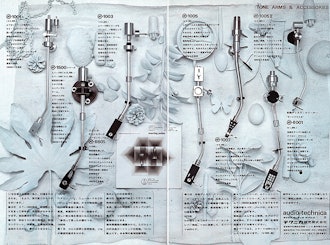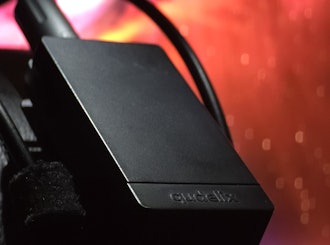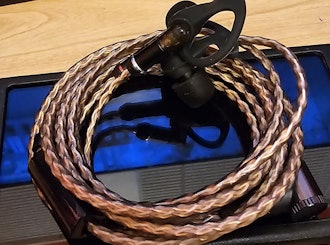Click to view our Accessibility Statement or contact us with accessibility-related questions


























Showing 1 of 127 conversations about:

ko403ok
26
Jan 4, 2019
bookmark_border
High-end power cables take the longest time to break in, due to the thickness of the wires.

OllieTheBear
54
Jan 9, 2019
bookmark_border
ko403okI suggest put rubber boots on and stopm them. I’ll brake the cable in faster

DanTreview
159
Jan 10, 2019
bookmark_border
OllieTheBearI bet $50 some audiofoole out there has tried this....

OllieTheBear
54
Jan 10, 2019
bookmark_border
DanTreviewI can’t speak for headphones burning, but “cable burning” just comfirms that there are large amounts of BS in our hobby

ko403ok
26
Jan 11, 2019
bookmark_border
OllieTheBearMorrow is the only one I'm aware of that offers AC power cable break in. That said, it took fully two months for CruzFirst M-1s to settle into my system. O boy, the waiting was worth all the patience.
verifonix
1181
Jan 12, 2019
bookmark_border
ko403okGod damn you sound like the exact person this shit is aimed at..

OllieTheBear
54
Jan 12, 2019
bookmark_border
verifonixIt’s all mental in my opinion. I am an electrician and I know for sure that cables don’t change unless there is a physical or chemical intervention. Assuming that audio cables are not exposed ro corrosive environment or stopmed on. Running low voltage/low current does not change the inner composure of the cable therefore it wouldn’t change the resistance of the material. Other electrical components such as tubes or bulbs do change with time as a result of constant heating/cooling. A tube amp needs it’s tubes replaced as they deteriorate over time and sound will change. Cables do not IMHO

ko403ok
26
Jan 12, 2019
bookmark_border
verifonixVerifonix has said, "After unboxing, I listened to it for 15 minutes and left them plugged in to allow them to burn in. After 50 hours of burn-in, some harshness that was there was gone and the sound signature seems settled." Burn- in. Settled. Is there anything else you'd like add?
verifonix
1181
Jan 13, 2019
bookmark_border
ko403okWhat's that got to do with thousand dollar power cables though?

jeremya
82
Jan 28, 2019
bookmark_border
OllieTheBearOne of the best theories I’ve heard to explain the burn-in phenomenon of cables is the slow changes in the molecular grain orientation of the cable material as electricity passes through it, much like water running over a riverbed (the stones which are rough at first become smooth over time, thus decreasing turbulence):
See:
https://en.m.wikipedia.org/wiki/Grain_boundary
Particularly the part about “Effect to the electronic structure”:
“In the case of metals grain boundaries increase the resistivity as the size of the grains relative to the mean free path of other scatters becomes significant.”
The aggregate resistivity (the sum of all resistance within the cable) may not change appreciably, but the accuracy of transient information (electrons arriving in the same order and tempo as they were transmitted) may be effected slightly by the grain structure (as localities of tiny resistance, those rough-edged rocks in the stream, are re-aligned or smoothed over)... which translates into “smearing” as some have described it. The brain is incredibly sensitive to timing.
(Edited)

DanTreview
159
Jan 29, 2019
bookmark_border
jeremyaAnd yet this phenomenon seems only to exist within the audio cabling world... I wonder if NASA builds a spacecraft worrying that it won't work after launch because the cables inside it are not burned in. Or if Honda freaks out because of all the meters and meters of cabling inside the Prius aren't burned in yet. [ad infinitum]
I'm not saying it isn't real, but man, I find it strikingly odd that I never hear so much as a mouse fart's amount on "cable burn in" within any other type of electronic enthusiast circle...

jeremya
82
Feb 6, 2019
bookmark_border
DanTreviewI can think of a couple reasons:
- The systems and machines you describe are purposefully engineered with very different tolerances than the human auditory system. Most of our modern machines are based on logic circuits, and very few of their systems would be built with highly discriminatory circuits requiring precise sampling of analog inputs with extreme time domain sensitivity (radar, radio, and other communication systems, along with some telemetry gatherers, are possible exceptions here — but how many of these are closed systems that deal with highly repeatable phenomena?).
- Logic circuits are built around a system of checks for voltage within a certain rage (“do I see 5V +/- 1V? If yes, engage function. Otherwise, ignore it, or do something else instead.”). The tolerance is required because the electrical systems in these environments (particularly cars) are often quite turbulent. Inaccuracy is therefore built into the equation; however, when sensitivity (fidelity) demand increases, tolerance decrease.
- Shunyata has posted videos on YouTube discussing the use of their cabling to ensure the proper performance of ultra-sensitive medical equipment.
- It’s ironic that you used NASA as an example, because Nordost cut their teeth building precision cabling for the space shuttle program. :^) It was after the challenge of that project (and other aerospace ventures) that the founder of Nordost decided he could take what they had learned and apply it to rewiring his home audio system... and shortly thereafter the company pivoted into the hifi space.
(Edited)
Related Posts

storyboardtech
Finding your groove: getting into vinyl with Audio-Technica
I’d like to think that I could’ve been friends with the late Hideo Matsushita, founder of Japanese Hi-Fi powerhouse Audio-Technica. If I could, I’d travel back in time to 1960’s Tokyo, where a young Matsushita curated “vinyl listening sessions” at the Bridgestone Museum of Arts, exposing visitors to the sounds and possibilities of high end audio and the warmth of vinyl records. I imagine sitting with him in a mod coffee shop, listening to the stories of what he witnessed in those sessions, the conversations he had with visitors, and what ultimately motivated him to head back to his small apartment above a ramen restaurant and start an audio company of his own. In the histories I’ve read regarding AT’s humble beginnings, Matsushita’s motives seem clear. Produce high end audio at affordable prices, bringing audio excellence into spaces and to customers that simply didn’t have access to it before. His first two products, the AT-1 and AT-3 phono cartridges did exactly that, and...
Dec 6, 2023

Viltaria
Would Drop be able to provide power-adaptors (plugs) for those based in other regions (Euro, Oceania, Asia, etc)?
Apr 14, 2024

bipolarman
Would this be a good match (for my hard to drive) HFM HE560 Phones? My magni sound good but seems a bit underpowered. Any help please, Thanks.
Apr 12, 2024
Gsager
Is it best to use the high gain setting with 300 ohm headphones? And what is the cutoff between high and low gain settings and headphone impedence? Maybe a stupid question, but I'm new to this. Thanks.
Apr 12, 2024
merrick97
Should I exchange the PC38X for better headphones?
I bought the PC38X headphones FOR GAMING and they are great, but I have NO use for a Microphone since I don't do competitive gaming and I was wondering if there were better headphone options at a similar price without a headphone, where (presumably) more of the cost was put into making it sound better. I also find that my PC38X don't get quite as loud as I would like and I was wondering if a cheap amp like the iFi Go link would draw a little more volume out of my phones. https://www.amazon.com/dp/B0BN6MM822?psc=1&ref=ppx_yo2ov_dt_b_product_details I went with the PC38X since it was considered the best bang for buck headphones. I care most about using spatial apps like DOlby Atmos and DTS Headphone:X. Suggestions are welcome.
Apr 11, 2024

her3tic
Are these copies of the Audiotechnicia ATH-M50Xs? The specs are quite similar and the design is definitely inspired by them.
Apr 11, 2024
Trending Posts in Audiophile

Simthaniel
Rigs
Modded headphones with qudelix at the core
When I received the Qudelix 5K, I had already modified a pair of Superlux HD-681 headphones. I previously soldered my own balanced connections to the drivers, providing multiple ways to connect and...
Apr 14, 2024

brothamike
A decent set of IEMs
I am in the midst of a 300 hour burn-in but, I will say I am enjoying how this set sounds so far. Before I received these which was btw late by a few weeks, I purchased a Sony/Kimber Kable MMCX...
Apr 12, 2024
merrick97
Should I exchange the PC38X for better headphones?
I bought the PC38X headphones FOR GAMING and they are great, but I have NO use for a Microphone since I don't do competitive gaming and I was wondering if there were better headphone options at a similar price without a headphone, where (presumably) more of the cost was put into making it sound better. I also find that my PC38X don't get quite as loud as I would like and I was wondering if a cheap amp like the iFi Go link would draw a little more volume out of my phones. https://www.amazon.com/dp/B0BN6MM822?psc=1&ref=ppx_yo2ov_dt_b_product_details I went with the PC38X since it was considered the best bang for buck headphones. I care most about using spatial apps like DOlby Atmos and DTS Headphone:X. Suggestions are welcome.
Apr 11, 2024

LostnAmerica
Sound Signature of the Grell Project.
Wondering what type of sound signature the Drop Grell project headphones will have or trying to attain. Any update would be appreciated.
Apr 8, 2024

Fabulous
Looking for a gaming/content audio setup
Hello! I'm looking for recommendations on audio setups. I'd be planning on using it mostly for gaming. Preferably I'd like a pair of large closed back headphones since I have a big head and jaw. I'd also like to hear myself through my mic with mic monitoring. As far as budget goes, I don't really have one. But under 600$ would be nice. I can go higher if needed. The audio setup would be connected to a high performance PC. Thank you in advance for any recommendations!
Apr 4, 2024

1plsd
$10 Drop Coupon Email not sent?
Trying to buy some gear off Drop for the first time. I was told I would receive an email with a welcome to drop $10 off promo. I never received that email. Drop was able to send me emails for my login token and email for Password update. But for some reason the $10 off coupon was never sent to me.
Mar 31, 2024

NMPacella
New here
Hello, I just joined, primarily for the audiophile products. Looking at purchasing the NHT C3 speakers for our new living room. Space is about 15 feet wide by 33 long and they will fire long ways. Space is just for general listening, music room with all equipment is downstairs, so hoping they will fill it with sound nicely. Cheers.
Mar 18, 2024


